2024 Vintage Report
2024 Vintage Report
Every vintage tells a story shaped by the land, the people, and the weather. The 2024 growing season began with uncertainty after a severe cold snap in January. Like most BC wineries, our vineyards suffered significant winter damage. All early signs, including bud dissections, indicated that we could expect little to no crop and limited shoot growth.
Even though we were anticipating a near 100% crop loss in our estate vineyard, we still had work to do, including pruning. We decided to prune the vines mostly as we normally do, while also working on regeneration of the vines to ensure their survival and a healthy crop in the years ahead.
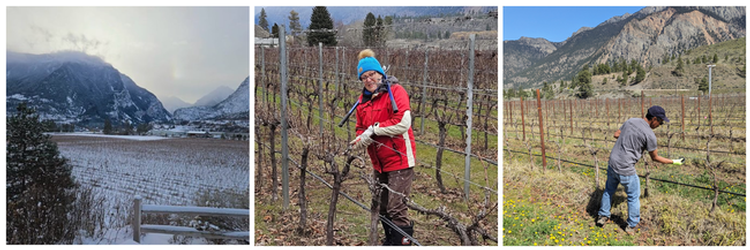
With the arrival of spring, we were thrilled to see that most of our vines had survived the very harsh winter. Our vineyard manager Chris Marquardt explained, “Our commitment to the land and the sustainable practices we’ve had in place for many years contributed to the high survival rate of our vines. Healthy soils create healthy plants that are strong enough to face the considerable challenges we have seen in recent years.”
Spring and early summer were marked by cool, overcast days including frost and cooler temperatures through late April. We saw an early bud break on April 24th followed by significant growth in the vineyard in late May and June.
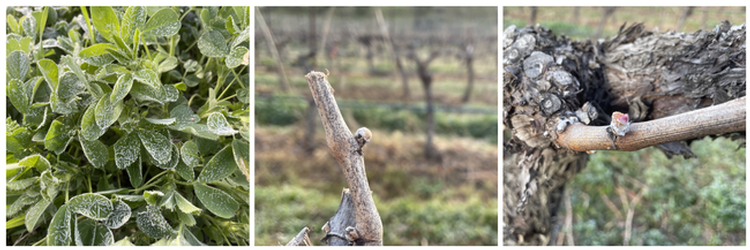
Our vineyard team had a lot of work to keep up with this growth, despite limited productive buds. We had particularly windy conditions in June, which had an impact on our Riesling blocks during flowering. With some positive signs as the season progressed, we adjusted our forecast to approximately 20-30% of our normal crop.
Bloom started on schedule mid-June, particularly in our signature Cabernet Franc and Riesling vines. Conversely, in our Merlot and Cabernet Sauvignon blocks, there was little to no fruit. Our vineyard team worked on retraining these vines to prepare them for 2025.
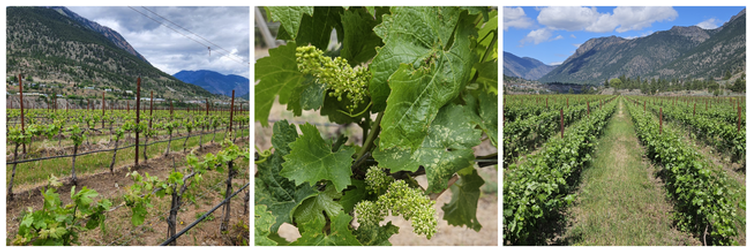
As the season progressed, July and August brought warm, dry weather, although temperatures stayed below extreme highs. We had very few days above 39 degrees Celsius and, we started to see the very early stages of veraison on August 11th.
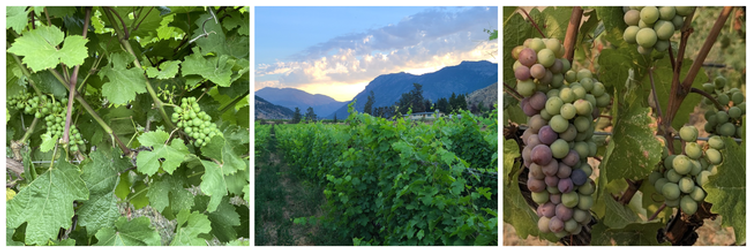
The ripening period from veraison onwards was excellent. The slow ripening conditions, paired with healthy fruit and no smoke threats, allowed us to patiently wait for optimal maturity. We started harvest on September 13th with Chardonnay for our Blanc de Blanc Traditional Method Sparkling wine.
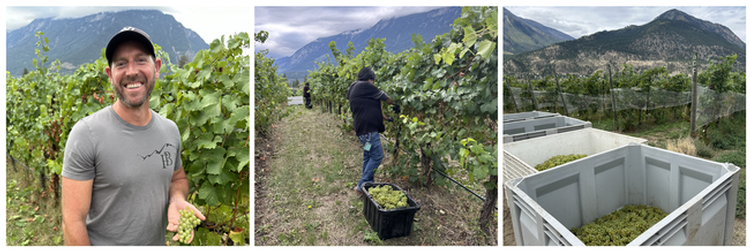
September continued with warm days but turned wet towards the end of the month. An overcast and damp October, with minimal frost issues, led to a fall with beautiful yellowing of the leaves in our vineyard until late in the season.
We completed harvest a little earlier than normal on October 18th with Cabernet Franc from our Red Rock Vineyard.
Although the overall crop was very small, the balance of acids and sugars was better than in 2023, with lower pH levels and good sugar levels, contributing to vibrant wines.
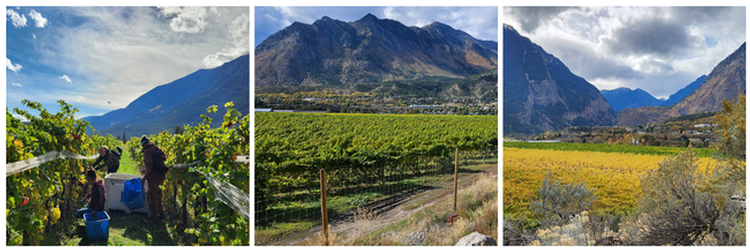
An Innovative Solution: Our “Here & There” Collection
Early in the season, anticipating a very small harvest, we set out on a unique and innovative way forward. We ventured beyond our borders to the renowned vineyards of Washington, seeking to create a unique expression of our winemaking tradition. We partnered with a winery in Washington, where our winemaking team could produce wine with grapes from Washington using our protocols and in our winemaking style.
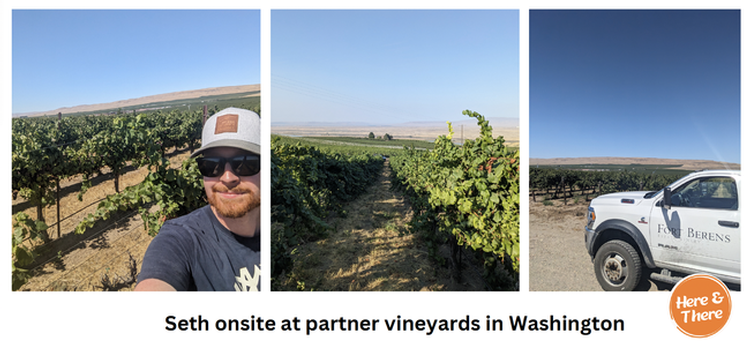
Featuring hand-picked grapes from select vineyards in Washington, we made these wines in our style. Our Here & There wines were crafted by our winemaking team in both Washington and Lillooet. Our winemaker Alex Nel stayed in Lillooet to work on our estate grown grapes while he also oversaw our assistant winemaker Seth Jex, who, after working several harvests in Ontario, Lillooet, New Zealand, and South Africa, looked after harvest, crush, and fermentation of our Washington grown grapes.
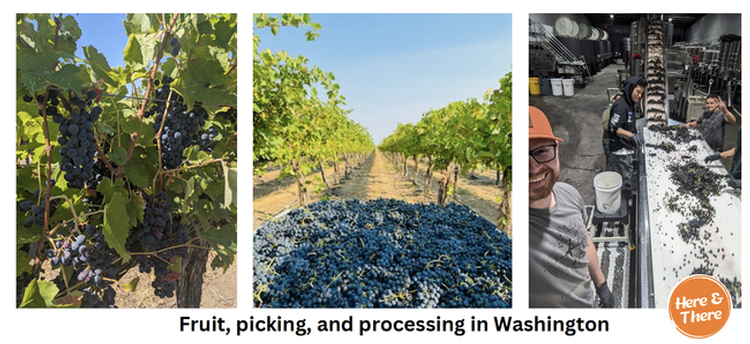
The wines from grapes grown in Washington have been bottled separately with a distinct label in our Here & There collection.
To read a full account of our 2024 harvests in both Lillooet and Washington, click here.
Our combined 2024 harvests were still smaller than normal, resulting in approximately:
- 45 tons of estate fruit (about 30% of a normal harvest)
- 68 tons of Washington fruit
- 113 tons of total fruit (combined about 75% of a normal harvest)
What to Expect from our 2024 Vintage
From our Lillooet estate grapes, we produced very small quantities of Riesling, Reserve Riesling, Pinot Gris, Blanc de Blanc, and Grüner Veltliner for our whites. For red, we harvested Pinot Noir, Cabernet Franc, and Cabernet Sauvignon. Alex explained, “Our estate white wines are fresh with lovely aromatics, while our estate reds show great tannin structure and rich colour. Notably, our Red Rock Cabernet Franc and Grüner Veltliner are showing exceptional promise and are the standouts from our estate harvest.”
From the Washington grapes, we produced Riesling, Pinot Gris, Chardonnay, and Rosé. Each varietal was sourced from single, select vineyards. Seth explained, “I am particularly excited about our Washington Rosé. We made it from Syrah grapes from a vineyard planted in 1998 in the Wahluke Slope AVA (American Viticulture Area) in Washington. This Syrah Rosé is inspired by South African Syrah Rosés.” Both Seth and Alex have worked with Syrah for Rosé in South Africa, and we can't wait for you to try this one.
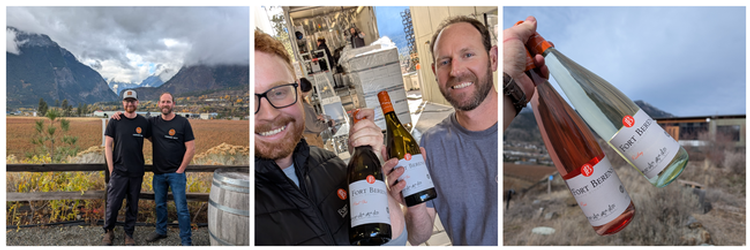
We will start releasing our 2024 Washington wines in early April. They are expressive, youthful and fresh, vibrant, and perfect to enjoy this spring and summer.
Additionally, we are pleased to share that we have produced a limited release Vineyard Cider Rosé again, which we will be releasing this spring.
With two estate vintages in a row at roughly 30-35% of our normal production, we are grateful to have been able to produce a collection of wines from Washington grapes. Through resilience and adaptability, we navigated the challenges of 2024, crafting wines from both Lillooet and Washington grapes that reflect the character of this unique season. This vintage is a testament to resilience, respect for the land, and the spirit of exploration.
While the journey has had some challenges over the years, it is one we are passionate about. We are deeply grateful to everyone who has shared in our journey and has supported us through the challenging and the wonderful times. When you reach for our wines and when you share them with your friends and family, you help keep us going, you help keep our winery viable, and you help us keep our team employed and doing what we enjoy. Thank you for your love and support, today and always.
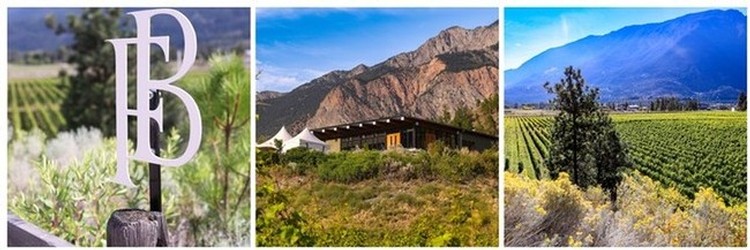
Principles of Food & Wine Pairings
Principles of Food & Wine Pairings
The holiday season is a fun and joyous time of year. It marks a time of celebration including get-togethers with family and friends, holiday parties, and many festive dinners. With more wine-drinking opportunities, we get lots of questions about which wines are best to serve for different occasions or what new wine to try for a specific festive celebration.
Many food and wine pairing recommendations are classic and straightforward based on the meat. These pairing charts say, for example, to pair chicken with Chardonnay, turkey with Pinot Noir, and cheese with Merlot. In reality, these simple suggestions ignore that there are as many different ways to prepare chicken, as there are ways to produce a Chardonnay.
For example, chicken with lemon, chicken tikka masala, fried chicken, or spicy Thai chicken are all chicken-based dishes, but each one tastes very different and each will pair better with different wines. When considering the food portion of the pairing, instead of looking at the main ingredient (i.e. chicken), we suggest focusing on the most prominent textures and dominant flavours in the dish.
Now, when thinking about the wine portion of the pairing, we suggest focusing on the style of wine rather than the grape varietal. A Riesling can be dry, off-dry, semi-sweet, sparkling, ice wine, late harvest, or many other styles. Therefore, it is better to focus on the style of wine. The style can be described in terms of acidity levels, sweetness, texture, and weight.
In this article, we will try to explain how to pair your wine so that you can make a great choice for yourself in any situation.

Here are a few general rules for pairing wines:
- Wine and food can complement each other, where the combination makes both the wine and the food taste better. It is also possible that the specific combination of wine and food can have a negative impact on each other. It can be magical when the food and wine pairing enhances the flavours of both. However, in most cases, we should be happy with a combination that is appropriate. Pairings are rarely perfect, although some are certainly much better than others.
- A poor or flawed wine is not going to taste any better with a well-paired dish. Conversely, an unpleasant dish will not be any more appealing with a nice wine. So, both the cook and the winemaker have a job to do.
- Choose a wine that you like. If you don’t like a certain type of wine, you won’t like it any better just because it’s paired appropriately. If you cringe at the aroma of an older Riesling because it reminds you of your neighbour’s stinky garage when you were growing up, you won’t like it any better at Christmas, even when it is nicely paired with a wonderful dish.
- Be open-minded. We all have our favourite wines and we all have wines that we avoid, particularly when we drink the wine by itself. When pairing wine with food, be open for new discoveries. Allow yourself to be surprised by new varietals. Or say yes to a varietal you don’t normally drink. You may very well learn to like a specific style of wine, especially if it’s paired with the right food. So be open.
Now that we have the general rules laid out, let’s look at the basic principles of good food and wine pairings.
Rule One: Match the acidity level in the wine and food
Both food and wine can range from acidic or tart to rich. Generally, more acidic food pairs well with more acidic wine and richer food pairs well with richer wines. Foods and beverages that are tart can cleanse your mouth, creating a refreshing sensation. On the other hand, some food and wine can be very rich and buttery, which coats the inside of your mouth.
Keep in mind that at the extremes of the acidic to rich range, pairings are more difficult. A salad with a very tart vinaigrette is very hard to pair with any wine, no matter how tart. With dishes that are super-rich, sometimes contrasting the richness with a more acidic wine, creates a more interesting pairing. For example, cheese fondue is super rich, but often does better with a more acidic white wine. Be careful though when pairing cream based sauces with tart white wines, because although it may cut through some of the fat, the combination is prone to curdle.
Rule Two: Match the weight in the wine and food
Pair a lighter dish with a lighter wine and a rich dish bursting with flavour with a rich heavy wine. The weight of a wine is influenced by alcohol, tannins, and flavour intensity. An unoaked Chardonnay will be lighter than a Chardonnay aged in French oak barrels. The weight from food comes from fat, flavours, and to some extent, sweetness. The wine and the dish should be equal partners, with neither overwhelming the other.
Rule Three: Tannins need fat
Tannins in a wine can make the palate feel dry. Fat from meat, fish, or even cheese can soften the drying sensation from the tannins making the wine smoother. So younger wines with more astringent tannins do better with fatter cuts like prime rib. Wines with softer tannins, through aging, pair better with leaner cuts of beef.
Rule Four: Heat needs sugar
Many cultures that serve spicy dishes have side dishes to cool things down. Many people think that wine will cool a spicy dish down, but alcohol can actually intensify the heat. Because heat needs sugar to cool things down, when thinking about a wine pairing for spicy food, it is best to pair spicy food with a slightly sweet lower alcohol wine. This is why a slightly off-dry Riesling pairs so beautifully with lightly spicy food, while a sweeter Late Harvest Riesling can balance even more heat.
Rule Five: Avoid mixing tannins and salt
Salt intensifies the impressions of tannins and alcohol. It also can reduce the expression of fruit characteristics. Too much salt on a steak or in an aged cheese, can make a subtle Cabernet Franc turn into a hard, tannic wine that lacks fruit.
Rule Six: Match the sweetness level in wine and food
With dessert, you want the wine to be sweeter than the food. Luckily there is a wide array of possible wines to pair with almost any dessert. There are appropriate dessert-pairing wines ranging from lighter sweet wines to ice wines to rich, heavy ports.
Often, we take special care with food and wine pairings for our special dinners with friends and loved ones. If you find that one of the pairings is not working out the way you had envisioned, consider replacing it with an alternative. There is no sense in drinking the whole bottle if the pairing isn’t working. Save the bottle for after dinner or enjoy it the next day with another meal.
Wine and Cheese
Because wine and cheese parties are so common during the holidays, we wanted to specifically address this pairing. Wine and cheese are often served together because the pairing can be quite stunning, enhancing both the wine and the cheese. However, there are literally hundreds of wine options and hundreds of cheese options, therefore making the pairings here very important.
When thinking about wine and cheese, all the principles from above apply without reservation. For example, soft, fresh and young (cow or goat) cheeses tend to be more tart with higher acidity. Therefore, try a crisp, fresh, dry white wine, like Sauvignon Blanc or Pinot Gris with these. Soft cheeses with a bit more age, like Brie and Camembert do well with a bit richer wine like Chardonnay or Gewürztraminer. Semi-aged cheese that is bit firmer (and a bit saltier) can work well with red wines like young, fruity Pinot Noir or even Cabernet/Merlot blends that are soft and smooth. Hard aged cheeses, which tend to be salty, work well with Vintage Port, which is low in tannins and semi-sweet. And if you like blue cheese? Blue cheese, which tends to be very salty, pairs nicely with sweeter white wines, like a Late Harvest Botrytis affected Riesling.
So, whatever is on your menu this holiday season, keep these guidelines and principles in mind as you think about your pairings. Maybe you’ll even discover a new favourite! Whatever wine and food pairings you choose in the days ahead, have fun and savour the joys of this most wonderful time of year.
Fort Berens Wine Pairings
At Fort Berens, we offer a wide range of wines each with a distinct style. While the vintage may taste different from year to year, we try to keep the style consistent.
Alluvium White
Wine style: Dry, crisp, with higher acidity, fruit forward, light-medium body, low tannins (unoaked).
Food pairings:
White fish, pan-seared with lemon, parsley and rice
Rocket salad, pine nuts, parmesan, olive oil, and lemon juice
Fresh soft cheeses
Pinot Gris
Wine style: Dry, crisp, with moderate acidity, fruit-forward, medium-bodied (from lees contact), low tannins (unoaked).
Food pairings:
Sautéed or grilled shrimp
Grilled summer vegetables
Shrimp and avocado sushi
Grilled chicken with Herbs de Provence off the BBQ
Goat cheese, brie
Riesling
Wine style: Slightly off-dry, crisp, with higher acidity, fruit-forward, medium-bodied (from a touch of sweetness), low tannins (unoaked).
Food pairings:
Mild chicken curry (based on Thai or Indian recipe)
Munster cheese or other red rind cheeses
Chardonnay
Wine style: Dry, crisp, with higher acidity, fruit-forward, medium-bodied, medium tannins (lightly oaked).
Food pairings:
Eggs Benedict - West Coast style with smoked salmon
Sautéed scallops
Rosé
Wine style: Dry, crisp, with higher acidity, fruit-forward, medium-bodied, low tannins (unoaked)
Food pairings:
Mushroom ravioli with parsley
Summer salad with grilled tuna
Bruschetta with tomatoes and shrimp
Alluvium Red
Wine style: Dry, round, with moderate acidity, fruit-forward, medium-bodied, soft tannins (oaked).
Food pairings:
Spaghetti Bolognese with basil
Pizza with finocchiona salami, black olives, mozzarella di bufala, and arugula
Pinot Noir
Wine style: Dry, round, with moderate acidity, fruit-forward, medium-bodied, soft tannins (oaked).
Food pairings:
Grilled filet of salmon smoked on a cedar plank
Grilled quail with tomato and corn salsa
Pulled pork sandwich (not too spicy)
Merlot
Wine style: Dry, round, smooth, with low acidity, fruit-forward, full-bodied, soft tannins (oaked).
Food pairings:
A “real” hamburger made from ground sirloin on a homemade sesame toasted bun
Leaner steaks from the BBQ, like striploin smothered in Fort Berens’ BBQ sauce
Boneless saddle steak of venison on the BBQ
Cabernet Franc
Wine style: Dry, round, smooth, with low acidity, full-bodied, medium tannins (oaked).
Food pairings:
Juniper braised short ribs
Roast leg of lamb with garlic and rosemary
Shredded slow roasted duck with balsamic glazing
Meritage
Wine style: Dry, round, smooth, with low acidity, full-bodied, medium tannins (oaked).
Food pairings:
Best cuts from the beef: tenderloin, prime rib or rib-eye with potato wedges
Lean cut of venison on the BBQ with polenta
Late Harvest Riesling
Wine style: Off-dry to semi-sweet, with higher acidity, rich fruit, medium-bodied (from the sweetness), low tannins (unoaked), low alcohol.
Food pairings:
Cheesecake
Sautéed vanilla pears with Zabaglione
Wild raspberry crème caramel
Grandmother’s apple pie with vanilla ice cream
Reserve Wine & Food Pairings
Fort Berens Reserve Wine Pairings
At Fort Berens, we offer a wide range of wines each with a distinct style. Over the years, we have been able to cultivate and refine our approaches in the vineyard and cellar and have expanded our collection to include a full series of small lot, ultra premium reserve wines which express the unique terroir of our region. We have currated for you here a quick reference to some food pairing suggestions that we think would work wonderfully with our reserve wines.

Chardonnay Reserve (White Gold)
Wine style: Dry, crisp, with juicy acidity, fruit-forward, medium-bodied, oaked.
Food pairings: Enjoy with a stuffed roasted chicken or turkey, baked ham, potatoes au gratin, or for the ultimate luxury, lobster.
Riesling Reserve
Wine style: Off-dry, crisp, with higher acidity and minerality, fruit-forward, concentrated, medium-bodied.
Food pairings: Enjoy the Riesling Reserve with spicy Pad Thai, cheese fondue, or a rich and creamy Alfredo sauce over linguine.
Red Gold
Wine style: Rich, velvety, full-bodied, long and intense finish, plush tannins.
Food pairings: Red Gold is the perfect wine to pair with your finest cuts of beef such as prime rib or a well-marbeled porterhouse steak. You can also enjoy this bold wine with big game such as a hearty moose stew.
Pinot Noir Reserve
Wine style: Concentrated, savoury earthy flavours, bright cherry fruit, elegant, long finish.
Food pairings: While a fireplace is not required, it is certainly recommended while enjoying this wine paired with a fire-roasted tomato lentil stew, grilled salmon, or roasted duck. It's also a great choice to pair with a traditional turkey dinner for the holidays.
Cabernet Franc Reserve
Wine style: Opulent blueberry and blackberry aromas, purple floral perfume, medium body, ripe tannins, long finish.
Food pairings: This wine pairs beautifully with lamb, duck, or a fresh, housemade tomato and basil pizza.
Meritage Reserve
Wine style: Earthy, intensly structured, powerful, high acidity and tannins, boldy flavourful.
Food pairings: Enjoy this wine with roasted lamb, grilled steak, spaghetti bolognese, or lasagna.
Fort Berens: 2024 Harvest Update
2024 Harvest Update
We are excited to share that we have now completed our 2024 harvest. It has been a challenging year filled with despair and worry, yet also filled with excitement, innovation, hard work, and pioneering spirit.
Like most BC wineries, our vineyards suffered significant winter damage earlier this year. As a result of the cold snap in January, we were originally anticipating a near 100% loss in our estate vineyard.
With the arrival of the sunshine and warmer weather in spring, we were thrilled to see that most of our vines were still alive. Our estate vineyard fared better than expected in some of our blocks and we were projecting an overall harvest amount between 20-30% of normal. During the summer, it appeared that our signature Cabernet Franc and Riesling were both doing better than we originally anticipated. Conversely, in the blocks that didn't do as well, including our Merlot and Cabernet Sauvignon blocks, where there was little to no fruit, we worked on retraining the vines this year to prepare them for 2025.
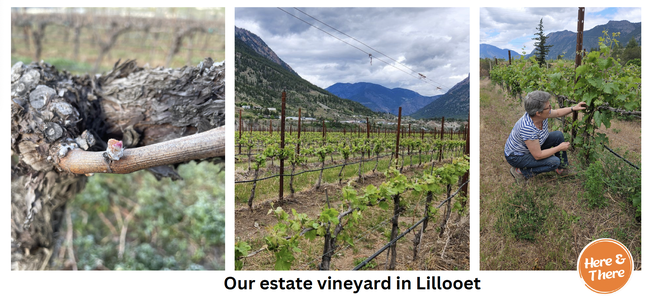
While we were anticipating a much smaller than normal harvest, we set out on a unique and innovative way forward. We ventured beyond our borders to the renowned vineyards of Washington, seeking to create a unique expression of our winemaking tradition. Just as the land has shaped generations of people who lived here long before us, this vintage is a testament to resilience, respect for the land, and a spirit of exploration.
We partnered with Sagemoor Estates in Washington State, where our team could produce wine from grapes from Washington, but using our protocols and in our style. We chose Washington because it is relatively close, and there are vineyards there that have similar growing conditions as our vineyards in Lillooet. We were able to use the tools and techniques that we use in Lillooet. With this collaborative process, our team made our Washington wines, just with grapes harvested from different vineyards, and pressed and fermented in a different cellar.

Our winemaker Alex Nel stayed in Lillooet to work on the harvest of our estate grown grapes while he also oversaw our assistant winemaker Seth Jex, who looked after the harvest of our Washington grown grapes.
We have now completed our harvest in both Lillooet and Washington, resulting in approximately:
- 45 tons of estate fruit (about 30% of our normal harvest)
- 68 tons of Washinton fruit
- 113 tons of total fruit (combined, it will be about 75% of our normal harvest)
About our estate harvest, our winemaker Alex explained, "A cloudy and windy spring showed signs of a late vintage, but it was the best ripening season I have had here. Very moderate temperatures during peak flavour development allowed for slow and even phenolic ripening. The Grüner Veltliner and Cabernet Franc grapes from our Red Rock Vineyard were outstanding. We are seeing well balanced acidities and aromatic whites, especially on the Grüner Veltilner, while the Cabernet Franc from our Red Rock Vineyard expresses lots of concentration, while being fruit-forward."
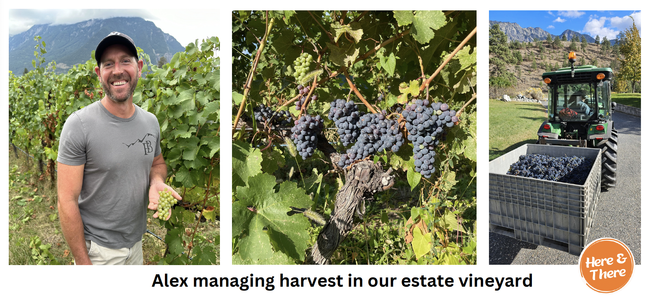
Our Assistant Winemaker Seth spent many weeks in Washington as our onsite visiting winemaker throughout harvest and crush. He was hands-on selecting the vineyards and grapes, tasting and monitoring the fruit, selecting the picking dates, hand picking and pressing the grapes, overseeing the fermentation, and arranging for the transport of the unfinished wines back to Lillooet.
Regarding our Washington harvest, Seth explained, "We are excited to showcase these Washington wines to you. They are expressive, youthful and fresh, vibrant, and perfect to enjoy in the spring and summer next year. We'll have Washington Riesling, Pinot Gris, Chardonnay, and Rosé. I am really pleased with all of these wines, and particularly our Washington Rosé. We made it from Syrah grapes, from a vineyard planted in 1998 in the Wahluke Slope AVA (American Viticulture Area) in Washington. This Syrah Rosé is inspired by South African Syrah Rosés. Both Alex and I have worked with Syrah for Rosé in South Africa, and we can't wait for you to try this one."

Seth recently returned from Washington, bringing the last of the unfinished Washington wine with him. From here, Alex and Seth will now work together on all of our Lillooet and Washington wines. The wines will be finished, aged, and bottled at our winery in Lillooet. While bottling is still far off, the wines from grapes grown in Washington will be bottled separately with a distinct label. It will be a really unique way to compare, contrast, and enjoy wines made by our team both from here in Lillooet and from there in Washington.
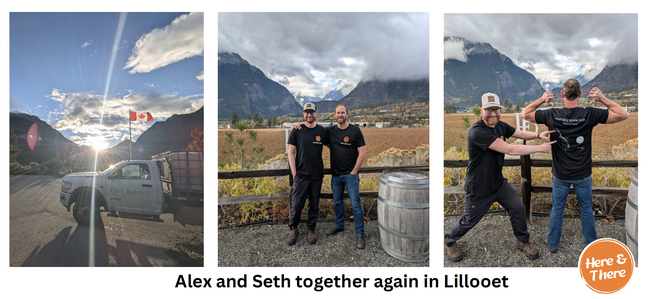
We have shared a number of reels, videos, and photos on our Facebook and Instagram pages, covering our harvest both from here and there. If you haven't yet, we invite you to check them out.
In addition to Alex and Seth, we would like to express our deep gratitude to all of our grape growing, harvest, and winemaking teams both here in Lillooet and in Washington. Special thanks to the team from Sagemoor for welcoming Seth and treating him so well this fall.
Despite the challenges of this harvest, we are passionate about what we do, and we remain committed to the Lillooet VQA, our beautiful community, and our BC wine industry. We are resilient, resourceful, and innovative, and our team is committed to ensuring our business is sustainable and that we can continue to produce world-class wines with the quality and passion that you have come to expect from us at Fort Berens.
Thank you for being a part of the journey with us.
Are you looking for a nice outdoor job? (CLOSED)
We are looking for a Grounds Maintenance person
The person will be responsible for maintaining the gardens, lawns and non-productive area’s on the Fort Berens property. Activities would include:
- Weeding, mowing, irrigating, pruning and weed spraying;
- Repair & maintenance of the landscape equipment and landscape features;
We are looking for someone with:
- knowledge and experience working with plants,
- a flexible self starter who is able to work independently and
- someone that pays a lot of attention to details.
The person needs to be physically fit and able to work outdoors in all kinds of weather.
This job is part-time with seasonal hours, the majority of the work being in the spring and summer. Remuneration will be based on experience.
Please apply by sending your resume to: heleen@fortberens.ca
Looking to expand our team (CLOSED)
Vineyard Manager (Filled)
This is an exciting opportunity for the right individual looking to advance their career in viticulture. The priority is finding the right person to join our team and help us grow premium grapes.
Responsibilities:
The Vineyard Manager will be responsible for:
- The labour in and the equipment and management of our20 acre vineyard;
- Building and managing a team of vineyard workers;
- Managing crop levels and costs within the vineyard budget;
- Employee health and safety policies and procedures
- Drafting and executing a sustainable vineyard plan, that delivers premium quality fruit, in co-operation with the wine maker;
- Drafting, updating and executing the Environmental Farm Plan and the BC Sustainable Practices for Vineyards.
The Vineyard Manager must be willing to work non-standard hours, including evenings and weekends, as needed.
Qualifications:
- 5 years experience in vineyard management;
- Intimate knowledge of BC viticulture, sustainable vineyard management and best practices;
- Knowledge of and experience with the operation of vineyard equipment;
- Highly motivated to learn and discover with us in this new viticulture region;
- A leader and team player, able to work and interact with many different players;
- Physically fit and able to work outdoors throughout the year;
- BC driver’s license; Pesticide Applicator Certificate; First Aid Level I; Forklift certificate.
- Functional knowledge of office software;
Offer:
We offer a permanent full time contract. Salary and benefits will be according to experience.
How to apply / contact information:
Apply by sending your resume and motivation before February 7 to:
Email: heleen@fortberens.ca
Fort Berens Estate Winery
Attn. Heleen Pannekoek
PO Box 758
Lillooet, BC V0K 1V0
250-256-7788
Location:
1881 Highway 99 north
Lillooet, BC V0K 1V0
About us:
Our vineyard is located in the magnificent Fraser Canyon across the Fraser River from the town of Lillooet. Lillooet is one of the "Hot Spots" in Canada, with a climate that is comparable with the South Okanagan. The Coast Mountains to the west of Lillooet keep rain and clouds away, ensuring that the vines receive plenty of sunshine. In 2009, we planted 20 acres with six varieties: Riesling, Pinot Gris, Chardonnay, Pinot Noir, Cabernet Franc and Merlot. In the future, we will expand with another 20 acres.
We make and sell premium, award winning BC VQA wines. We believe that great wines are grown, not made. To support us in growing premium grapes, we are looking for professional leadership in our vineyard. If you are qualified and are looking to live in a beautiful environment with affordable housing, please apply now!

